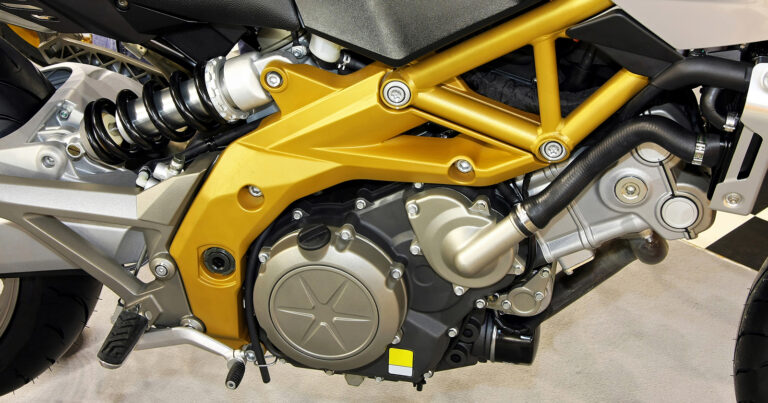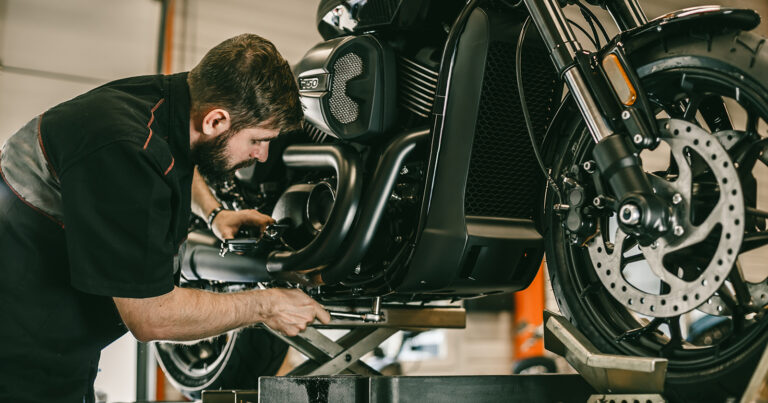How to Register a Motorcycle: Custom-Built Motorcycle Guide
This post may contain affiliate links. That means if you click and buy, we may receive a small commission (at zero cost to you). Please see our full disclosure policy for details.
It’s exactly two years since I, a skilled vehicle builder, started the construction of my dream motorcycle. Along the line, I had wanted to throw away the idea into the trash, but for the encouragement I received from friends. I felt discouraged, having repeatedly heard of the difficulty I had to face before I could register a custom built motorcycle. But thanks to my listening ears, dogged spirit, and determination to have something to my name as a custom motorcycle constructor.
In this article, you’ll learn, relearn, and unlearn all the essential information you need to register a motorcycle that is specially constructed and make it road-worthy and highway-ready. It would be best if you remembered that (depending on your state of residence) causing your custom-built masterpiece to become an official vehicle can be tricky or demanding.
But don’t worry—once you read this post—you will clear your doubt and have a straight and clear understanding of how things work in different states across the United States. The information here does not cover the registration of antique motorcycles. Most custom bikes today are assembled from new and used parts, not antique components, and the antique registration process involves additional information, more paperwork, and a stricter law enforcement agency review.
What Does a New Custom-Built Motorcycle Mean?
Now, we shall take my case as a typical example for review. When I, as an individual, assemble major components like aftermarket engine parts, frame, transmission, and body parts made by an authorized or licensed manufacturer, the end product is called a custom motorcycle. A homemade or home-built frame will not have a Vehicle Identification Number (VIN) until one is issued by the state through the local registration office. A new Vehicle Identification Number (VIN) is assigned by the state after the motorcycle passes an inspection.
Other than a manufacturing plant or company, an individual who brings together new motorcycle components produced by registered manufacturers is a custom builder. The motorcycle parts the builder purchased from the authorized manufacturer often come with a receipt, bills of sale, and the Manufacturer’s Certificate of Origin (MSO) — a key certificate that proves part origin. However, the title for a motorcycle with a builder’s title lacks a standard Manufacturer’s Certificate of Origin (MCO). The builder must prove ownership of all major parts for a builder’s title.
The second thing you must know is that a new custom motorcycle is built for private use, not resale. That is why it is not built by licensed manufacturers but by individuals with the requisite skills and knowledge to build their own motorcycle in a garage.
Where Does The Process Start?
To make the process less cumbersome, finding out how to register a custom motorcycle should begin long before you present your finished bike at the registration office. Before you purchase any component, the entire registration plan should have begun. The moment you conceive the idea of piecing a motorcycle in your garage, you should also start thinking of how to register the final vehicle.
Registration begins with knowing the rules of your state’s DMV and the local law enforcement agency, because every state’s department operates under its own law and may request different forms, documents, and verification steps for a specially constructed motorcycle. For instance, in Texas, you must obtain a letter issued by a Texas Department of Motor Vehicles (TxDMV) Regional Service Center (RSC) prior to applying for title and registration. You may need to have your assembled vehicle inspected by an auto theft law enforcement officer to obtain a VIN.
Essentials to Register New Custom Motorcycle
To avoid having your registration delayed or limited, you must prepare certain things beforehand. These details, however insignificant they may appear, can affect your ability to obtain a title.
1. Title of Ownership
Your title is proof that the motorcycle belongs to you. It’s also the official document that confers ownership. When purchasing the frame or engine block, ensure the VIN number matches what you have on the Title of Ownership. It eases the verification process and facilitates transferable registration if you decide to sell.
Whether you purchase a new frame or build your own homemade frame, there are forms you must fill. If you purchase a frame with VIN, things get easier. Always treat your local registration office as a key partner in this process.
Keep evidence, receipts, MSO, and all documents for every major component. These will be required during vehicle verification. Documentation of where every component comes from is important when registering a motorcycle built from salvaged parts.
2. Custom Motorcycle Safety Inspection
This is a crucial part of the process. I remember when I took my first custom motorcycle for inspection. The law enforcement agency officer asked, “How safe is this custom motorcycle?” I was unprepared and lost my chance to register one of my best builds.
The safety inspection involves checking the road readiness of your custom motorcycle. The officer will verify if the VIN numbers on your major components match the Manufacturer’s Certificate. Keep all paperwork, receipts, proof, and bills. The finished motorcycle must meet all federal and state safety and equipment requirements to be considered roadworthy.
Using certified components from registered manufacturers helps ensure eligibility. You may hire a local shop to do a pre-inspection before the official review. In fact, you may need to have a local motorcycle shop look over the motorcycle prior to the law enforcement agency inspecting it.
3. Emissions Certification
Many builders applying for a builder’s title or a bonded title fail this step. States require emissions checks measuring exhaust and sound levels. Visit your DMV website or local office to determine what is applicable in your state. Being proactive here can save time and avoid delays.
4. Builders Title for Motorcycle Limitations
Being allowed to build a custom build does not mean you can build an unlimited number of bikes per year. States limit the number of builder’s titles you may receive. Going beyond that threshold may require you to become a licensed dealer or business owner.
Some states limit it to six; others allow up to ten per year. If you plan to build multiple motorcycles, ask the registration office for additional information.
5. Finalizing the Details of Your Registration Process
Assuming you have gathered all necessary files, the next step is to book an appointment with your local DMV. Be prepared to pay the sales tax, registration fee, and other applicable charges. The registrar will need all your completed forms and documents before issuing your final title.
6. Insuring is as Important as Building Your Motorcycle
You cannot complete your registration without insurance. Your insurance policy is proof that your vehicle is covered, and the DMV may not continue the registration process unless this is present. Always keep your insurance documents handy.
How to Renew Motorcycle Registration
You can renew your registration documents every year. Typically, the DMV office will send you a reminder to bring to your awareness that your papers have expired or are edging towards expiry.
You need to renew the registration yearly, and there are four different means through which you can renew your registration. They include personal information by mail, phone, or online. Depending on your state, each of these methods is viable and effective. Contact your local DMV office to determine which method applies to your state.
Renewal in Person
This is the best-advised way to get your custom-built motorcycle registration done with little hassle. All you need to do is to show up at your local DMV office with the renewal notice you receive. Added to that are your license and proof of renewal fee payment. At that point, you’ll get your new registration certificate and stickers.
Renewal via Mail
If you can’t go to your DMV office, you can renew your motorcycle registration by mail. Simply respond to your renewal notice, send a copy of your proof of insurance to your state’s DMV, and you’ll receive your new registration certificate and stickers by mail.
Renewal via Phone
You must have your VIN, registration renewal notice, and license plate number ready. Call your local DMV office, provide your payment method, and after processing, your new registration certificate and stickers will be mailed to you.
Online Renewal
Every DMV office has a website where you can renew your registration online in some states. You’ll receive a renewal notice, and to complete the process, you’ll need to provide proof of insurance, smog certification (if required), your Vehicle Identification Number, and payment method. After renewal, your new registration and stickers will be mailed to you.
Challenges in Titling Motorcycles
Salvage branding significantly complicates the titling process for motorcycles, as it indicates that the bike has previously been damaged or deemed a total loss by an insurance company. This branding can affect the bike’s value and legal status, requiring additional inspections and paperwork to prove that the motorcycle is safe and roadworthy. Additionally, titles for motorcycles can get lost over time, which further complicates registration by making it difficult to verify ownership and history. In such cases, owners must often go through a lengthy process to obtain replacement titles, which may involve submitting detailed documentation, proof of ownership, and sometimes even bonded titles to satisfy state requirements and ensure the motorcycle can be legally registered and ridden.
Documents and Items Required at Motorcycle Registration Offices
You have made all necessary arrangements, and it is time to visit your local DMV office for the final appointment. What documents and items will the office require of you as you step in? Here are the things you shouldn’t forget to accompany to the motorcycle registration center. Remember, some states may require more or less. For example, in Wisconsin, you will need to submit a complete application to the Wisconsin Department of Transportation to title and/or register a homemade motorcycle. You’ll need to find out what the local registration office needs.
- A completed Title or Registration Application
- A Vehicle safety inspection certificate
- A filled-out Statement of Construction.
- Proof of insurance
- Emission Inspection certificates
- Proof of payment of the registration fee
- Your Out-of-State Registration (applicable to a new builder or someone who buys his components and parts outside the state of his residence)
- Documents showing Proof of ownership, such as receipts and bills for sale. Depending on the state, a notary may be asked to review and verify the documents you present.
- Sales tax and registration fees are due.
What’s more, the motorcycle registration application form is right here. The sample below is for Oregon; there may be variations when you compare it to other states’ application forms. You can check with your local DMV office to have an accurate application. The internet is also there for you to use if you need to download the application as it applies to your state of residence.
Here are related common questions.
Can I register a motorcycle with no frame number?
It asks if a candidate can become US president without the Electoral College. Your guess is as good as mine. Regardless of the legal jurisdiction or the laws of the State of the Union, you cannot register an unfinished frame. The Driver and Vehicle Licensing Agency (DVLA) considers the frame as being the bike. At every point in time, a new frame requires a new number. It becomes difficult to prove how old your frame is if the serial number doesn’t have a serial number.
What does a Q-registration mean?
You’ll need to visit DVLA website to get the full details of the process of a Q-registration. A Q registration stands for a kit motorcycle or rebuild, which differs from an original registration.
How do I recover a lost motorcycle title?
First, your motorcycle title is the document that confers ownership of the vehicle on you. When you sell the bike, your signature is also needed on the title to sign it over to the bike’s new owner. And even though replacing and recovering your lost motorcycle title may seem seamless and simple, it is better to avoid losing the proof. Keep it safe and secure in a fireproof or water-resistant safe or a safety deposit box at a bank.
Now, let’s get back to your question. There are three steps to replace your lost motorcycle title. Ensure you have copies of the following documents: Vehicle Identification Number, Photo ID, Year and make of motorcycle, and License plate number.
- Go to your state Department of Motor Vehicles (DMV) website
- Search for “Title Replacement” or “Request a Title.” Page and open the application form.
- Complete the application form by entering your name, address, city, and state. Fill in the field for the vehicle identification number of the motorcycle, as well as, the year and make of the bike and the license plate number.
What do I do if I purchase a frame without a Vehicle Identification Number (VIN)?
It is simple. If you buy a frame or engine with no VIN, you need to acquire the MSO from the seller. This will show that you have legally acquired those components. Temporarily, you can use the MSO pending the time the VIN will be issued to you. But do not forget to discuss with your local registration center how you can obtain your VIN.
Do I need a VIN if I built (not bought) my own frame?
That’s a brainer. You won’t need a VIN if you’re the builder of your frame or engine. No local registration office will demand a VIN or MSO from you if the frame it’s built. But you must follow the procedure. Typically, the registration office will issue you a home-built VIN permanently attached to the vehicle’s frame. Do not take that for granted. You can be the first to approach the registration for this home-built VIN. Ensure you ask for a conspicuous location where the VIN will be pasted on your frame for easy identification.
What if my components have different titles?
There is nothing to worry about if you have multiple parts with different titles. It doesn’t mean you have been scammed or won’t be able to get your new construction registered. You’ll approach your local registration office for advice on what to do. Usually, you should complete all inquiries regarding this before you go ahead and buy the salvaged part.
You now have all the information at your fingertips concerning registering your custom-constructed motorcycle across states. You know it is not so much about your passion for building a custom motorcycle. The legal framework and operational guidelines of your state of residence and local DMV offices are important considerations when building a custom motorcycle.
- How to Make Harley Davidson Motorcycle Faster
- How to Make Harley Davidson Pipes Sound Louder
- The Best Air Intakes for Harley Davidson







